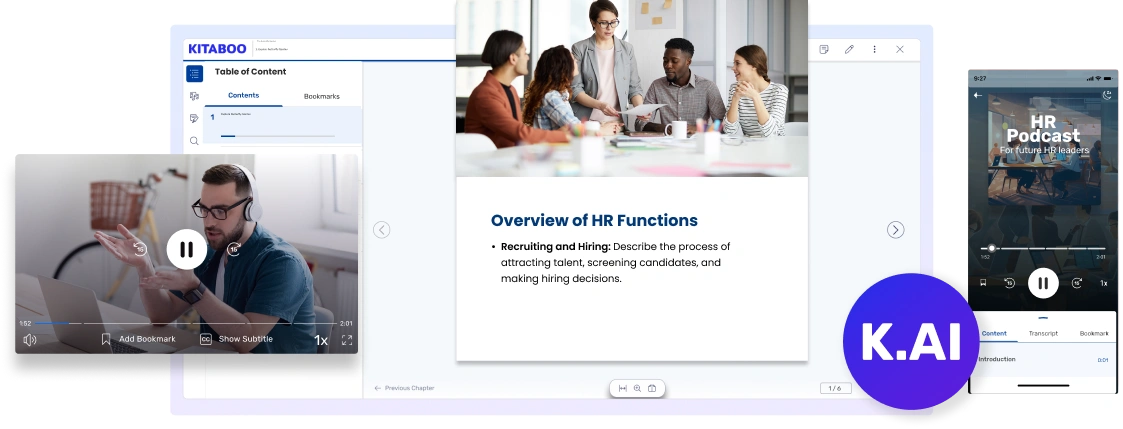Distribute Training Manuals.
Training Resources. eBooks
Create engaging, trackable training manuals that boost learning outcomes. Say goodbye to
boring PDFs and hello to interactive, multimedia-rich content.

How Does KITABOO Help You?
Aviation
Training
- Digital-First Training Delivery
- Interactive Learning Content
- License & Certification Management
- Seamless SSO Access
- Real-Time Analytics
Learn More
Healthcare
Training

- Compliance Tracking & Reporting
- Digital Manual Conversion
- Gamified & Badge-enabled Learning
- Mobile-first Training Delivery
- Certification Management
Learn More
Empower Your Training Programs
with Cutting-Edge Digital Solutions
Transform your exam prep, professional training, and skill development offerings with KITABOO's advanced platform.
Our solution powers both self-paced and classroom learning, from compliance-based courses to certifications.
Secure
Protect your intellectual property. Safeguard your valuable training content with robust DRM protection. Ensure your IP remains secure while providing seamless access to authorised learners.
Measure
Gain actionable insights. Leverage comprehensive analytics for in-depth engagement tracking. Make data-driven decisions to enhance your training programs and prove ROI.
Engage
Deliver rich learning experiences. Integrate multimedia elements for more engaging and effective training. Provide learners with interactive content accessible on any device, anywhere.
Modernize
Go paperless and transform your training content with KITABOO. Convert your content print materials into interactive, cost-effective experiences that meet today’s learning needs.
Our customers love us
With KITABOO You Can

Universal Access
Empower learners with anytime, anywhere training across all devices and platforms.
Rapid Updates
Keep content current with frequent updates, ensuring all users access the latest information.
Compliance-Based Training
Easily create, distribute, and track compliance training to meet regulatory requirements.
Enable In-text Annotations
Allows learners to highlight, bookmark and make notes in your content.
Certifications
Issue and manage digital certifications to recognize learner achievements and validate skills.
Collaborate and Share
Educators and learners can share and collaborate on the same platform.
What Training Companies Love About KITABOO
Integrate with Existing LMS
KITABOO offers seamless integration with your LMS and other tools, streamlining your training processes and reducing administrative workload. This ensures a smooth and efficient learning experience for both learners and trainers.
White-Label App
for Consistent Branding
Maintain your brand identity with our customizable white-label solution. Provide a seamless, branded experience from course selection to completion.
Learn Anytime, Anywhere
With KITABOO, learners can access training content even without an internet connection. Our offline access feature allows for seamless learning on the go, ensuring uninterrupted education whenever and wherever it's convenient.
One-Click Distribution to Any
Device, Anywhere
Reach your learners wherever they are. KITABOO ensures your training materials are accessible across all devices, maintaining consistency and quality.
Case Studies
Our Training Success Stories
Fueling Aviation Training Success: KITABOO’s Impact on User Grow...
Discover how a leading American aviation training provider soared to new heights...
Dental Education & Training Center Triples User Growth...
Discover how an American dental education & training center achieved ...
KITABOO Insight Enables 24X7 Training for 1000+ Dentistry Practitioner...
One of our clients – a leading dentistry training center, wanted to provide th...
FAQs
KITABOO employs robust DRM and encryption to ensure your training content remains secure and protected.
Yes, KITABOO seamlessly integrates with most popular LMS platforms through API and SSO capabilities.
KITABOO supports a wide range of formats including PDF, EPUB, HTML, and various video/audio formats.
KITABOO complies with WCAG 2.2 guidelines and offers features like text-to-speech and high-contrast modes.
Yes, KITABOO provides comprehensive analytics on learner progress, engagement, and completion rates.
Yes, KITABOO offers offline access capabilities for learners without consistent internet connectivity.
KITABOO is highly scalable and can accommodate organizations from hundreds to millions of users.
Yes, KITABOO is fully responsive and optimized for learning on smartphones and tablets.
Absolutely, KITABOO offers extensive white-labeling options to align with your brand identity.
KITABOO regularly releases updates and new features, typically on a quarterly basis.






